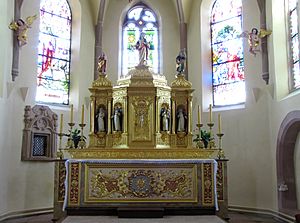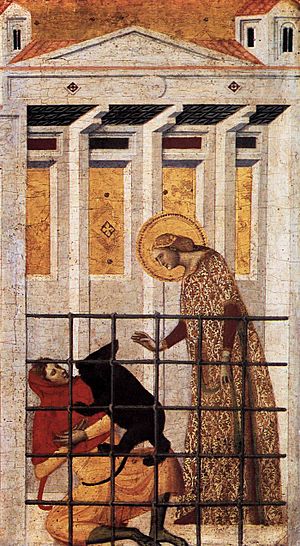Columba of Sens facts for kids
Quick facts for kids SaintColumba of Sens |
|
|---|---|

Main altar of Église Saint-Colombe, Hattstatt, France. The statue on top depicts Columba of Sens (click on picture to enlarge).
|
|
| Born | c. 257 |
| Died | 273 Sens, France |
| Venerated in | Roman Catholicism |
| Major shrine | Abbey of Sens |
| Feast | December 31 |
| Attributes | she-bear, crowned maiden in chains, with a dog or bear on a chain, holding a book and a peacock's feather, with an angel on a funeral pyre |
| Patronage | Andorra |
Columba of Sens (born around 257, died 273) was a brave young woman known for her strong Christian faith. She was born into a noble family in Spain. As a child, she moved to France to avoid trouble for being a Christian. There, she was given the name Columba, which means "dove."
Columba became very important in France. People built a chapel where her remains were kept. Later, a large church called the Abbey of Sens was built in her honor. This place became a popular spot for people to visit and show their respect.
Columba is often shown as a young woman wearing a crown and chains. Sometimes, she has a dog or a bear on a chain next to her. She might also be holding a book or a peacock's feather. Her most famous symbol is a female bear. Her special day, called a feast day, is celebrated on December 31.
Who Was Saint Columba?

Columba was born in Zaragoza, a city in northwestern Spain. Her family was important, but they were not Christians.
When she was a child, Columba left Spain and traveled to France. She was baptized there, which means she officially became a Christian. She chose the name Columba, meaning "dove."
Some stories say she left Spain because she heard about a "more beautiful religion" in France. Others say she wanted to avoid being punished for her Christian beliefs. She eventually settled in Sens, a town in north-central France.
Columba's Brave Story
In 273, the Roman Emperor Aurelian came to Sens. He ordered that all Christians in the town be put to death.
However, Columba was very beautiful and noble. Emperor Aurelian was impressed by her. He wanted her to marry his son.
Columba refused to marry his son because of her faith. So, the emperor had her put in the town's amphitheater.
A female bear protected her there. The emperor then tried to burn both Columba and the bear alive. But the bear escaped, and a sudden rainstorm put out the fire.
Finally, Columba was sentenced to death. She was executed, possibly near a fountain called d'Azon.
Her Legacy and Symbols
Columba was honored throughout France for many years. Historical buildings in Sens still show how much people respected her.
A chapel was built over her remains. Later, the Abbey of Sens was built there. This abbey became a place where people would go on pilgrimages to honor her.
Columba is the patron saint of Andorra. People also pray to her to ask for rain or to prevent dry weather.
Her main symbol is a female bear, which reminds us of the bear that protected her. Her feast day is celebrated every year on December 31.
See also
 In Spanish: Colomba de Sens para niños
In Spanish: Colomba de Sens para niños

